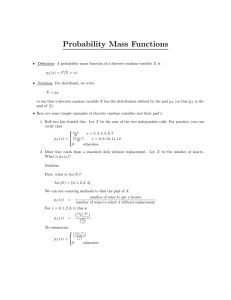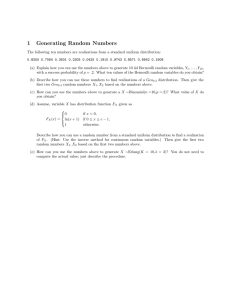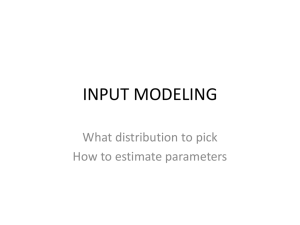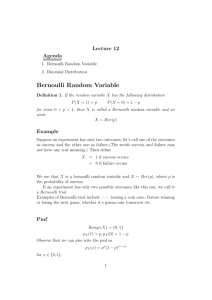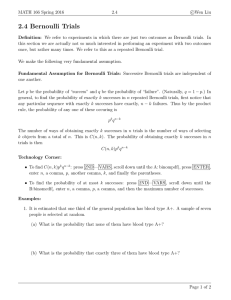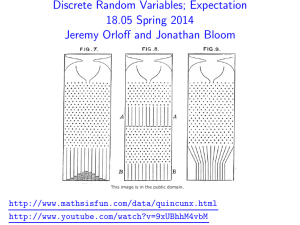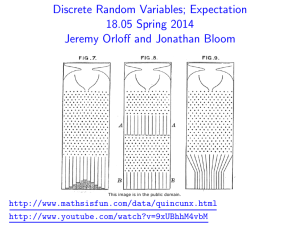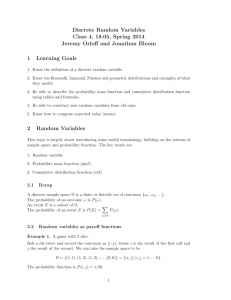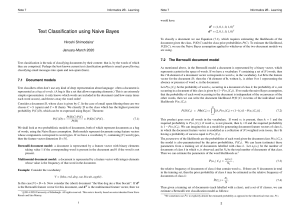Bayes in Practice & Random Variables stat 430 Heike Hofmann
advertisement
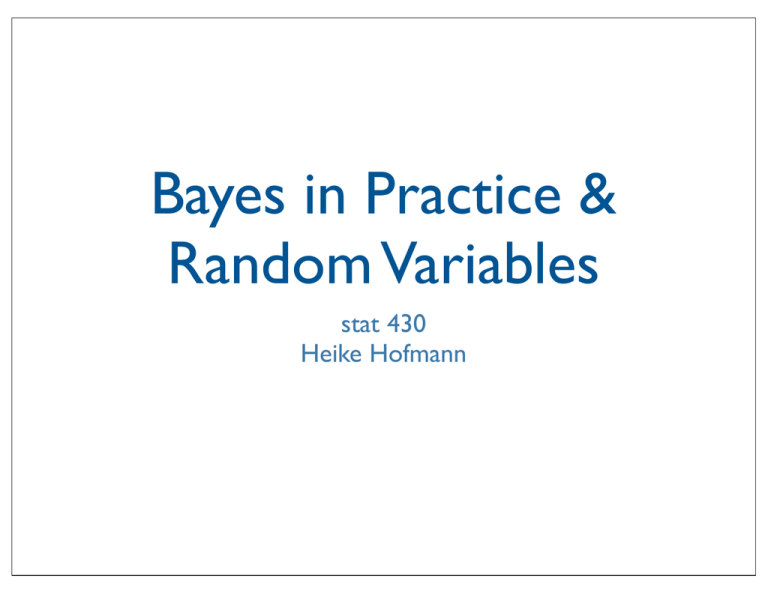
Bayes in Practice &
Random Variables
stat 430
Heike Hofmann
Outline
• Bernoulli Experiments
• Discrete Random Variables
• Expected Value
Bayes
Tree Diagrams
Visualization of Total Probability
24
The probability of a nodeCHAPTER
is
given
as
the
product
of
all
B1 P(A| B1)
A B1
probabilities along the edges
P(B )
B2 P(A| B2)
back to the root (Definition
A B2
P(B )
of conditional probability)
1
2
P(Bk)
Bk
P(A| Bk)
cover
A
Bk
The probability of an event
The probability
of each
is the sum
of node
the in the tree ca
tiplying all probabilities from the root to th
probabilities of all final
diagrams).
Summing
up all the involved
probabilities in the l
nodes (leaves)
rule).
If the set B1 , . . . , Bk is a cover of the sample space Ω
for an event A by (cf. fig.??):
Bayes’ Rule
• Bayes Theorem
P (A) =
k
�
i=1
P (Bi ) · P (A|B
Let B1 , B2 , B3 , ... be a cover of the sample
space, then
is a cover of the sample space Ω, we can compute the probab
P (A|Bj ) · P (Bj )
g.??): P (B |A) = P (Bj ∩ A) =
�k
j
P (A)
i=1 P (A|Bi ) · P (Bi )
P (A) =
k
�
i=1
P (Bi ) · P (A|Bi ).
∩ A)
P (A|Bj ) · P (Bj )
= �k
A)
for all j and ∅ =
� A ⊂ Ω.
Example: Forensic Analysis
Setup: DNA is found at a crime scene
Probability for a (random) DNA match is I in10 Mio
DNA test procedure is sometimes faulty:
false negative:
P(test neg | match) = 0.0000001
false positive: P(test pos | no match) = 0.000001
Assume, police has a positive test result from a
suspect.
What is the probability that they have found the
perpetrator?
Example: Monty Hall Problem
Setup:
- Two goats and one car behind doors
- Game show contestant has to pick a door (but
doesn’t open it yet)
- Host reveals one of the goats
- Final choice for contestant: stick with original pick or
switch to the other door?
What is the probability of winning the car?
Bernoulli & Binomial
Bernoulli Experiments
• Outcome: success or failure; 0 or 1
• P(success) = p, P(failure) = 1 - p
• sequence of (independent) repetitions:
sequence of Bernoulli experiments
X
function has two main properties: Properties of a pmf
Sequence
of
Bernoulli
Experiments
must be between 0 and 1 0 ≤ p (x) ≤ 1 for all x ∈ {x
X
�
all values is 1 i pX (xi ) = 1
k repetitions of Bernoulli experiment:
�
E[h(X)]
= space
h(x
· pX (xi )of=:k-digit
µ
Write
sample
asi )sequence
binary numbers:i
•
•
Ωk = {
00...00, 00...01, 00...10, 00...11,
...,
11...00, 11...01, 11...10, 11...11}
X : Ω �→ R is called a random variable.
1, x
ll values is 1
�
i pX (xi )
=1
Probability
assignment
�
E[h(X)] =
h(x ) · p (x ) =: µ
in Bernoulli Spaces
i
X
i
i
• If experiments are independent:
Ωk = {For sequence
00...00, s00...01,
00...10,
00...11,
in sample space
•
...,
P(s) = pi (1-p)k-i
if s has11...00,
i successes
and 11...10,
k-i failures.
11...01,
11...11}
(Hint: substitute 0s by 1-p and 1s by p)
Ω �→ R is called a random variable.
# of sequences with exactly i successes is
� �
k
i
� �
n
•
i
Ωk = {
00...00, 00...01, 00...10, 00...11,
Binomial
distribution
...,
11...00, 11...01, 11...10, 11...11}
•
X : Ω �→ R Let
is called
a random
variable.
X be the
number of
successes in n
independent Bernoulli
� �experiments with P
k
(success)=p,
i
then
� �
n k
P (X = k) =
p (1 − p)n−k
k
(i)
•
0 ≤ P (A) ≤ 1
Ωk = {
00...00, 00...01, 0
Random Variables
...,
11...00, 11...01, 1
• Definition:
AAfunction
calleda arandom
random variab
function X : Ω �→ R is called
variable
� �
k
image of X:
i
im(X) = X(Omega) = set of all possible
� �
values X can take
n k
P (X = k) =
p (1
k
Examples:
•
#heads in 10 throws,
#of songs from 80s in 1h of LITE 104.1 (or KURE 88.5 FM),
(i)
0 ≤ P (A) ≤ 1
winnings in Darts
(ii)
P (∅) = 0
Discrete R.V.s
• If the image of a random variable is finite
(or countable infinite), the random variable
is a discrete variable
• probability mass function
Probability
mass
function
�
2 �
V ar[X] =
(x
i−
(pmf)
VE[X])
ar[X] =· pX (x
(xi ) − E[X])
i
i
i
2
·
pX (x)
:=function
P (X = px)
is called the probability mass func
The
X (x) := P (X = x) is called the pro
unction
has mass
two main
properties:
of a pmf
p
probability
function
has two Properties
main properties:
Pro
X, if and only
if pX is a pmf, iff
Theorem:
ust(i)
be all
between
1 01between
≤
1 for
∈(x)
{x1≤
, x12
X (x)
values
be
0≤im(X)
and
1 0all≤xpX
0 ≤0must
pand
forpall
x in
X(x) ≤
�
�
ll (ii)
values
1 ofi pall
= {x1, x2, ... }
i ) = 1is 1for im(X)
X (x
theissum
values
i pX (xi ) = 1
•
•
•
E[h(X)] =
�
i
�
h(xE[h(X)]
) =: µh(xi ) · pX (xi
i ) · pX (xi=
i
Expectation
y if
Expected Value
es must be between 0 and
� 1 0 ≤ pX (x) ≤ 1 for all x ∈ {
2
V ar[X]
(xi − E[X]) · pX (xi )
�=
m of all values is 1 i pXi(xi ) = 1
n pX (x) :=
(X = x)value
is called
the probability
TheP expected
of random
variable X ismass fu
� that we Properties
ss functionthe
haslong
twoterm
main
properties:
of a pm
average
will see,
E[h(X)] =
h(xi ) · pX (xi ) =: µ
when we repeat the same experiment over
if
i
and over:
must be between 0 and 1 0�
≤ pX (x) ≤ 1 for all x ∈ {x1 ,
xi · pX (xi ) =: µ
�E[X] =
of all values is 1 i pX (xi ) =i 1
for additional function h, we get:
�
=00...00,
h(x
(xi ) =: 00...11,
µ
ΩE[h(X)]
00...01,
i ) · pX 00...10,
k ={
•
•
..., i
